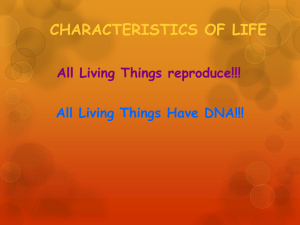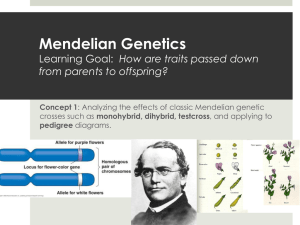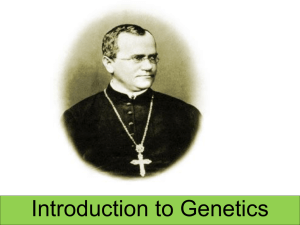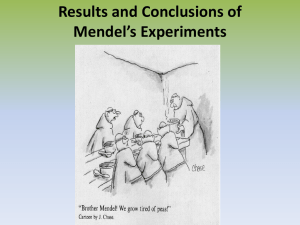ppt - eweb.furman.edu
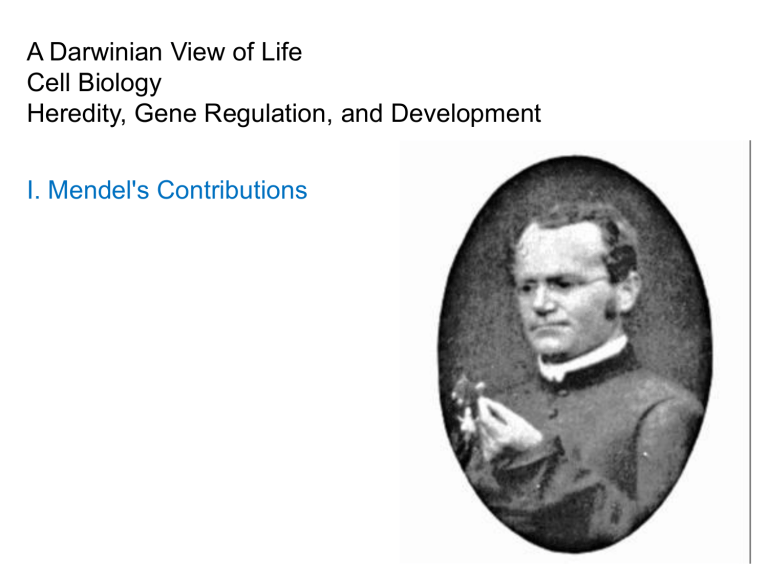
A Darwinian View of Life
Cell Biology
Heredity, Gene Regulation, and Development
I. Mendel's Contributions
I. Mendel's Contributions
A. Mendel’s Life:
- Born July 20, 1822 in Czech Rep.
- Entered Augustinian Abbey in Brno – 1843
I. Mendel's Contributions
A. Mendel’s Life:
- 1856-63: tested 29,000 pea plants
- 1866: Published “Experiments on Plant
Hybridization”, which was only cited 3 times in 35 yrs
- Died Jan 6, 1884 in Brno.
I. Mendel's Contributions
A. Mendel’s Life:
B. Pre-Mendelian Ideas About Heredity
Traits run in families….
I. Mendel's Contributions
A. Mendel’s Life:
B. Pre-Mendelian Ideas About Heredity
1. Preformationist Ideas
I. Mendel's Contributions
A. Mendel’s Life:
B. Pre-Mendelian Ideas About Heredity
1. Preformationist Ideas
2. Epigenetic
?
I. Mendel's Contributions
A. Mendel’s Life:
B. Pre-Mendelian Ideas About Heredity
C. Mendel’s Experiments
C. Mendel’s Experiments
1. Monohybrid Experiments
C. Mendel’s Experiments
1. Monohybrid Experiments a. reciprocal crosses
Pollen (purple) Ovule (white)
WHY??
Ovule (purple) Pollen (white)
C. Mendel’s Experiments
1. Monohybrid Experiments a. reciprocal crosses
PARENTAL CROSS
Pollen (purple) Ovule (white) Ovule (purple) Pollen (white)
Results falsified both the ovist and homunculan schools – hereditary information must come from both parents….
C. Mendel’s Experiments
1. Monohybrid Experiments a. reciprocal crosses b. crossing the F1 hybrids
Decided to cross the offspring in an F1 x F1 cross:
Got a 3:1 ratio of purple to white…. (705:224)
SO, the F1 Purple flowered plant had particles for white that were not expressed, but could be passed on.
- Proposed 4 ‘postulates’
(hypotheses) to explain his data:
1) hereditary material is
“particulate”
- Proposed 4 ‘postulates’
(hypotheses) to explain his data:
1) hereditary material is
“particulate”
2) each organism has 2 particles governing each trait
- Proposed 4 ‘postulates’
(hypotheses) to explain his data:
1) hereditary material is
“particulate”
2) each organism has 2 particles governing each trait
3) if the particles differ, only one
(‘dominant’) is expressed as the trait; the other is not expressed
(‘recessive’).
- Proposed 4 ‘postulates’
(hypotheses) to explain his data:
1) hereditary material is
“particulate”
2) each organism has 2 particles governing each trait
3) if the particles differ, only one
(‘dominant’) is expressed as the trait; the other is not expressed
(‘recessive’).
4) during gamete formation, the two particles governing a trait SEPARATE and go into DIFFERENT gametes…
- Proposed 4 ‘postulates’
(hypotheses) to explain his data:
1) hereditary material is
“particulate”
2) each organism has 2 particles governing each trait
3) if the particles differ, only one
(‘dominant’) is expressed as the trait; the other is not expressed
(‘recessive’).
4) during gamete formation, the two particles governing a trait SEPARATE and go into DIFFERENT gametes.
Subsequent fertilization is RANDOM
(these gametes are equally likely to meet with either gamete type of the other parent…and vice-versa).
This is Mendel’s Principle of Segregation
C. Mendel’s Experiments
1. Monohybrid Experiments a. reciprocal crosses b. crossing the F1 hybrids c. Proposed four postulates
2. Monohybrid Test Cross
Mendel’s ideas rested on the hypothesis that the F1 plants were hiding a gene for ‘white’
Hypothesized Genotype = Ww
C. Mendel’s Experiments
1. Monohybrid Experiments a. reciprocal crosses b. crossing the F1 hybrids c. Proposed four postulates
2. Monohybrid Test Cross
Ww
Mendel’s ideas rested on the hypothesis that the F1 plants were hiding a gene for ‘white’
Hypothesized Genotype = Ww
½ W
½ w
Based on the hypothesis of segregation, the plant should produce two types of gametes at equal frequency.
HOW can we see these frequencies, when we can only actually observe the phenotypes of the offspring?
C. Mendel’s Experiments
1. Monohybrid Experiments a. reciprocal crosses b. crossing the F1 hybrids c. Proposed four postulates
2. Monohybrid Test Cross
½ W ww
Mate with the recessive parent, which can only give recessive alleles to offspring w
Ww
½ w
Mendel’s ideas rested on the hypothesis that the F1 plants were hiding a gene for ‘white’
Hypothesized Genotype = Ww
C. Mendel’s Experiments
1. Monohybrid Experiments a. reciprocal crosses b. crossing the F1 hybrids c. Proposed four postulates
2. Monohybrid Test Cross ww
Mate with the recessive parent, which can only give recessive alleles to offspring w
½ W
½ Ww
Ww
½ w
½ ww
Mendel’s ideas rested on the hypothesis that the F1 plants were hiding a gene for ‘white’
Hypothesized Genotype = Ww
Genotypic
Ratio of offspring
C. Mendel’s Experiments
1. Monohybrid Experiments a. reciprocal crosses b. crossing the F1 hybrids c. Proposed four postulates
2. Monohybrid Test Cross ww
Mate with the recessive parent, which can only give recessive alleles to offspring w
½ W
½ Ww ½ W
Ww
½ w
½ ww ½ w
Mendel’s ideas rested on the hypothesis that the F1 plants were hiding a gene for ‘white’
Hypothesized Genotype = Ww
Genotypic
Ratio of offspring
Phenotypic
Ratio of offspring
C. Mendel’s Experiments
1. Monohybrid Experiments a. reciprocal crosses b. crossing the F1 hybrids c. Proposed four postulates
2. Monohybrid Test Cross
½ W ww
Mate with the recessive parent, which can only give recessive alleles to offspring w
Same as gamete frequencies of unknown parent
½ Ww ½ W
Ww
½ w
½ ww ½ w
Mendel’s ideas rested on the hypothesis that the F1 plants were hiding a gene for ‘white’
Hypothesized Genotype = Ww
Genotypic
Ratio of offspring
Phenotypic
Ratio of offspring
C. Mendel’s Experiments
1. Monohybrid Experiments
2. Monohybrid Test Cross
3. Dihybrid Experiments a. Parental cross
Round and Yellow Peas Wrinkled and Green Peas
C. Mendel’s Experiments
1. Monohybrid Experiments
2. Monohybrid Test Cross
3. Dihybrid Experiments a. Parental cross
Round and Yellow Peas
RRYY
RY
100% F1 = RrYy
Wrinkled and Green Peas rryy ry
C. Mendel’s Experiments
1. Monohybrid Experiments
2. Monohybrid Test Cross
3. Dihybrid Experiments a. Parental cross b. F1 x F1 cross
RrYy
X
RrYy
315 round, yellow (~9/16)
108 round, green (~3/16)
101 wrinkled, yellow (~3/16)
32 wrinkled, green (~1/16)
C. Mendel’s Experiments
1. Monohybrid Experiments
2. Monohybrid Test Cross
3. Dihybrid Experiments a. Parental cross b. F1 x F1 cross
RrYy
Monohybrid Ratios Preserved
X
RrYy
423 Round (~3/4)
~ 3:1
133 wrinkled (~1/4)
315 round, yellow (~9/16)
108 round, green (~3/16)
101 wrinkled, yellow (~3/16)
32 wrinkled,green(~1/16)
C. Mendel’s Experiments
1. Monohybrid Experiments
2. Monohybrid Test Cross
3. Dihybrid Experiments a. Parental cross b. F1 x F1 cross
RrYy
Monohybrid Ratios Preserved
X
RrYy
416 Yellow (~3/4)
~ 3:1
140 Green (~1/4)
315 round, yellow (~9/16)
108 round, green (~3/16)
101 wrinkled, yellow (~3/16)
32 wrinkled, green (~1/16)
C. Mendel’s Experiments
1. Monohybrid Experiments
2. Monohybrid Test Cross
3. Dihybrid Experiments a. Parental cross b. F1 x F1 cross c. His explanation
RrYy
Mendel's Principle of Independent Assortment :
During gamete formation, the way one pair of genes (governing one trait) segregates is not affected by (is independent of) the pattern of segregation of other genes; subsequent fertilization is random.
X
RrYy
Monohybrid Ratios Preserved Product Rule Predicts Combinations
¾ Round x ¾ Yellow = 315 round, yellow ( ~9/16 )
¾ Round x ¼ Green = 108 round, green ( ~3/16 )
¼ Wrinkled x ¾ Yellow =
¼ Wrinkled x ¼ Green =
101 wrinkled, yellow ( ~3/16 )
32 wrinkled, green ( ~1/16 )
F1: Round, Yellow: RrYy
Each gamete gets a gene for each trait:
R or r Y or y
RY Ry
R = ½, r = ½ rY
Y = ½, y = ½
So, if R’s and Y’s are inherited independently,
THEN each combination should occur ¼ of time.
ry
IF
the genes for these traits are allocated to gametes independently of one another,
then
each F1 parent should produce four types of gametes, in equal frequencies
c. His explanation: (including patterns of dominance)
Independent Assortment occurs HERE
c. His explanation: (including patterns of dominance)
Independent Assortment occurs HERE
Round Yellow = 9/16
c. His explanation: (including patterns of dominance)
Independent Assortment occurs HERE
Round Yellow = 9/16
Round Green = 3/16
c. His explanation: (including patterns of dominance)
Independent Assortment occurs HERE
Round Yellow = 9/16
Round Green = 3/16
Wrinkled Yellow = 3/16
c. His explanation: (including patterns of dominance)
Independent Assortment occurs HERE
Round Yellow = 9/16
(3/4) x (3/4)
Round Green = 3/16
(3/4) x (1/4)
Wrinkled Yellow = 3/16
(1/4) x (3/4)
Wrinkled Green = 1/16
(1/4) x (1/4)
C. Mendel’s Experiments
1. Monohybrid Experiments
2. Monohybrid Test Cross
3. Dihybrid Experiments
4. Dihybrid Test Cross
The hypothesis rests on the gametes produced by the F1 individual.
How can we determine if they are produced in a 1 : 1 : 1 : 1 ratio?
RrYy
¼ RY
¼ Ry
¼ rY
¼ ry
C. Mendel’s Experiments
1. Monohybrid Experiments
2. Monohybrid Test Cross
3. Dihybrid Experiments
4. Dihybrid Test Cross
Cross with a recessive individual that can only give recessive alleles for both traits to all offspring rryy
RrYy
¼ RY
¼ Ry
¼ rY
¼ ry
All gametes
= ry
¼ RrYy
¼ Rryy
¼ rrYy
¼ rryy
Genotypic
Frequencies in offspring
C. Mendel’s Experiments
1. Monohybrid Experiments
2. Monohybrid Test Cross
3. Dihybrid Experiments
4. Dihybrid Test Cross
Cross with a recessive individual that can only give recessive alleles for both traits to all offspring rryy
RrYy
¼ RY
¼ Ry
¼ rY
¼ ry
All gametes
= ry
¼ RrYy
¼ Rryy
¼ rrYy
¼ rryy
¼ RY
¼ Ry
¼ rY
¼ ry
Genotypic
Frequencies in offspring
And the phenotypes of the offspring reflect the gametes donated by the RrYy parent.
C. Mendel’s Experiments
D. Summary
1) Hereditary information is unitary and ‘particulate’, not blending
2) First Principle – SEGREGATION: During gamete formation, the two particles governing a trait separate and go into different gametes; subsequent fertilization is random.
3) Second Principle – INDEPENDENT ASSORTMENT: The way genes for one trait separate and go into gametes does not affect the way other genes for other traits separate and go into gametes; so all gene combinations in gametes occur as probability dictates. Subsequent fertilization is random.
E. The Power of Independent Assortment
1. If you can assume that the genes assort independently, then you can calculate ‘single gene’ outcomes and multiply results together…
For Example: AaBb x Aabb
- what is the probability of an Aabb offspring?
- What is the probability of an offspring expressing Ab?
- How many genotypes are possible in the offspring?
- how many phenotypes are possible in the offspring?
E. The Power of Independent Assortment
1. If you can assume that the genes assort independently, then you can calculate ‘single gene’ outcomes and multiply results together…
For Example: AaBb x Aabb
- what is the probability of an Aabb offspring?
Do the Punnett Squares for each gene separately:
For A: For B:
A a
A a
AA Aa
Aa aa
E. The Power of Independent Assortment
1. If you can assume that the genes assort independently, then you can calculate ‘single gene’ outcomes and multiply results together…
For Example: AaBb x Aabb
- what is the probability of an Aabb offspring?
Do the Punnett Squares for each gene separately:
For A: For B:
A a
A a
AA Aa
Aa aa
B b b b
Bb Bb bb bb
E. The Power of Independent Assortment
1. If you can assume that the genes assort independently, then you can calculate ‘single gene’ outcomes and multiply results together…
For Example: AaBb x Aabb
- what is the probability of an Aabb offspring?
Do the Punnett Squares for each gene separately:
For A: For B:
A a
A a
AA Aa
Aa aa
B b b b
Bb Bb bb bb
Answer the question for each gene, then multiply:
P(Aa) = ½ x P(bb) = ½ = 1/4
E. The Power of Independent Assortment
1. If you can assume that the genes assort independently, then you can calculate ‘single gene’ outcomes and multiply results together…
For Example: AaBb x Aabb
- what is the probability of an Aabb offspring?
- What is the probability of an offspring expressing Ab?
For A: For B:
A a
A a
AA Aa
Aa aa
B b b b
Bb Bb bb bb
Answer the question for each gene, then multiply:
P(A) = 3/4 x P(b) = ½ = 3/8
E. The Power of Independent Assortment
1. If you can assume that the genes assort independently, then you can calculate ‘single gene’ outcomes and multiply results together…
For Example: AaBb x Aabb
- what is the probability of an Aabb offspring?
- What is the probability of an offspring expressing Ab?
- How many genotypes are possible in the offspring?
For A: For B:
A a
A a
AA Aa
Aa aa
B b b b
Bb Bb bb bb
Answer the question for each gene, then multiply:
(AA, Aa, aa) = 3 x (Bb, bb) = 2 = 6
E. The Power of Independent Assortment
1. If you can assume that the genes assort independently, then you can calculate ‘single gene’ outcomes and multiply results together…
For Example: AaBb x Aabb
- what is the probability of an Aabb offspring?
- What is the probability of an offspring expressing Ab?
- How many genotypes are possible in the offspring?
For A:
A
- how many phenotypes are possible in the offspring?
A a
For B: b b
AA Aa
B Bb Bb a Aa aa b bb bb
Answer the question for each gene, then multiply:
(A, a) = 2 x (B, b) = 2 = 4
E. The Power of Independent Assortment
1. If you can assume that the genes assort independently, then you can calculate ‘single gene’ outcomes and multiply results together…
2. You can easily address more difficult multigene problems:
(female) AaBbCcdd x AABbccDD (male)
E. The Power of Independent Assortment
1. If you can assume that the genes assort independently, then you can calculate ‘single gene’ outcomes and multiply results together…
2. You can easily address more difficult multigene problems:
(female) AaBbCcdd x AABbccDD (male)
- how many types of gametes can each parent produce?
- What is the probability of an offspring expressing ABCD?
- How many genotypes are possible in the offspring?
- how many phenotypes are possible in the offspring?
E. The Power of Independent Assortment
1. If you can assume that the genes assort independently, then you can calculate ‘single gene’ outcomes and multiply results together…
2. You can easily address more difficult multigene problems:
(female) AaBbCcdd x AABbccDD (male)
- how many types of gametes can each parent produce?
For Female:
Aa Bb Cc dd
A, a B, b C, c d
2 2 2 1
For Male:
AA Bb cc DD
A
1
B, b c
2 1
D
1
2 x 2 x 2 x 1 = 8 1 x 2 x 1 x 1 = 2
E. The Power of Independent Assortment
1. If you can assume that the genes assort independently, then you can calculate ‘single gene’ outcomes and multiply results together…
2. You can easily address more difficult multigene problems:
(female) AaBbCcdd x AABbccDD (male)
At A:
- how many types of gametes can each parent produce?
- What is the probability of an offspring expressing ABCD?
At B: At C: At D:
A A
A AA AA a Aa Aa
B b
B BB Bb b Bb bb c
C Cc c cc
D d Dd
P(A) = 1 x p(B) = ¾ x p(C) = ½ x p(D) = 1 = 3/8
E. The Power of Independent Assortment
1. If you can assume that the genes assort independently, then you can calculate ‘single gene’ outcomes and multiply results together…
2. You can easily address more difficult multigene problems:
(female) AaBbCcdd x AABbccDD (male)
- how many types of gametes can each parent produce?
- What is the probability of an offspring expressing ABCD?
- How many genotypes are possible in the offspring?
- how many phenotypes are possible in the offspring?
At A:
A A
A AA AA a Aa Aa
At B:
B b
B BB Bb b Bb bb
At C: c
C Cc c cc
At D:
D d Dd
E. The Power of Independent Assortment
1. If you can assume that the genes assort independently, then you can calculate ‘single gene’ outcomes and multiply results together…
2. You can easily address more difficult multigene problems:
(female) AaBbCcdd x AABbccDD (male)
- how many types of gametes can each parent produce?
- What is the probability of an offspring expressing ABCD?
- How many genotypes are possible in the offspring? 2 x 3 x 2 x 1= 12
- how many phenotypes are possible in the offspring? 1 x 2 x 2 x 1 = 4
At A:
A A
A AA AA a Aa Aa
At B:
B b
B BB Bb b Bb bb
At C: c
C Cc c cc
At D:
D d Dd
E. The Power of Independent Assortment
1. If you can assume that the genes assort independently, then you can calculate ‘single gene’ outcomes and multiply results together…
2. You can easily address more difficult multigene problems.
As you can see, IA produces lots of variation, because of the multiplicative effect of combining genes from different loci together in gametes , and then combining them together during fertilization … we’ll look at this again; especially with respect to Darwin’s 3 rd dilemma.




